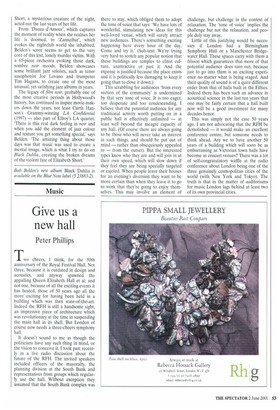Jazz
The dark side
Stuart Nicholson
If there is such a thing as wholesome violence, I think I portray it,' says in-vogue crime writer and raconteur James Ellroy. He's talking about the convoluted, gritty plot of his novel The Black Dahlia, based around the real-life murder of Elizabeth Short, a 22-year-old Hollywood call girl who was found cut in half in a vacant lot in the early hours of 15 January 1947. Part of his 'Los Angeles Quartet', The Black Dahlia is located in a dark, psychotic LA of the immediate post-war years and explores a Cimmerian spectrum of human emotions
from psychosexual jealousy to misogyny.
Such deep imagery inspired jazz composer and saxophonist Bob Belden to create a 12-part programmatic suite based on Short's tragic life. 'My fascination with the noir side of Los Angeles drew me to the writings of James Ellroy,' he says, speaking from his New York home. 'His novel The Black Dahlia was a fantasy based on the world that surrounded Elizabeth Short and the dark side of LA life.'
On his new album Black Dahlia, Belden creates a soundtrack for an inner cinema of the mind, depicting Short's plunge into those darker elements of Los Angeles night-life, a recurring theme in film noir of the Forties and Fifties. It shows a brutal and corrupt society at odds with America's optimistic view of itself in the period immediately following the second world war.
This unusual subject matter for a jazz recording, ranging from the spiritual geography of betrayal to the strange purity of dishonourable intentions, is portrayed through a series of haunting yet moving scenes evoking the atmospheric soundtracks of classic film noir. One key film of the genre, Roman Polanski's ChinatOwn (1974), had a score by Jerry Goldsmith that was a particular inspiration. The film was set in 1939, but Goldsmith's music was undeniably modern,' says Belden. 'I didn't want to mimic music from 1947 for Black Dahlia, I just wanted to create the feeling in the listener's mind of a Los Angeles in 1947.'
Belden's score immediately succeeds in depicting the classic noir images of the big city at night with its moody, atmospheric lighting, deserted streets and vulgar neon signs. Originally film noir was based on detective thrillers by the likes of Raymond Chandler, James M. Cain and Dashiell Hammett. Chandler, in particular, was fascinated by the fast-evolving noir genre that reflected how the cynicism of wartime combat created a climate where moral barriers could be crossed and recrossed at will — a theme Ellroy picks up in novels like The Black Dahlia or The Big Nowhere, with its communist witch-hunts and insanely violent murders.
Forties noir films like The Big Sleep (1946) or The Naked City (1948), acted out in mouldy hotel rooms, the flyspecked offices of hard-boiled private detectives and streets with menacing shadows, reflected this bleak reality. The tough, side-ofthe-mouth dialogue and the depiction of evil in higher places than the underworld was reflected in the soundtrack music with shrill trumpet blasts and haunting saxophone melodies.
It's a saxophone, the instrument that came of age in the big bands, that carries the haunting melody of David Raskin's score for 'Laura" (1944), which heralded the mature film noir of the late Forties, while the low-life sex and drugs at a 'hot jazz' jam session in Phantom Lady (1944) is exactly the environment where Elizabeth Short, a mysterious creature of the night, acted out the last years of her life.
From Danza d'Amour', which captures the moment of reality when she realises her life is doomed, to 2annzibar', which evokes the nightclub world she inhabited, Belden's score seems to get to the very core of this lost, lonely murder victim. With a 65-piece orchestra evoking those dark, sombre noir moods, Belden showcases some brilliant jazz soloists, such as tenor saxophonist Joe Lovano and trumpeter Tim Hagans, to create one of the most unusual, yet satisfying jazz albums in years.
The legacy of film noir, probably one of the most creative periods in Hollywood's history, has continued to inspire movie-makers down the years, not least Curtis Hanson's Grammy-winning LA Confidential (1997) — also part of Ellroy's LA quartet. 'There is this real dark feeling in noir and when you add the element of jazz colour and texture you get something special,' says Belden. 'The amazing thing about those days was that music was used to create a mental image, which is what I try to do on Black Dahlia, creating the broken dreams of the violent fate of Elizabeth Short.'
Bob Be/den's new album Black Dahlia is available on the Blue Note label (5 23883-2).











































































 Previous page
Previous page